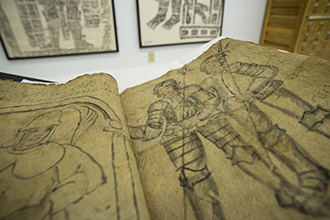Rare Mexican pictorial manuscript collection available online

For the first time, scholars worldwide have access to one of the world's top five collections of rare documents outside of Mexico. (Photo by Paula Burch-Celentano)
Before, researchers had to travel to Tulane if they wanted to consult these documents; this is the first time some of the manuscripts have been published. Researchers will now be able to view the Tulane documents side-by-side with manuscripts held in other repositories in Mexico, Europe and the United States, enabling them to make new connections and breakthroughs in their interpretation.
The collection contains land claims and grants, property holdings, census data, fiscal accounts and royal Mixtec genealogies. The manuscripts are painted on surfaces such as animal hide, fig bark paper, maguey and European paper, and they date to the early contact period (1500 to 1700 A.D.). That was a time of rapid cultural change as indigenous Mesoamerica and Spanish colonists formed a syncretic colonial society.
These unique manuscripts are tangible evidence of this cultural fusion as native scribal traditions and writing systems subsisted long past initial Spanish colonization. Instead of total European domination, these colonial societies are better described as a melting pot of cultures, says Hortensia Calvo, Doris Stone Director of the Latin American Library.
The collection was digitized as part of the Tulane Digital Library, established in 2010 through funding from the Office of the Provost.
Mary Sparacello is a communications specialist in the Office of Development Communications.
